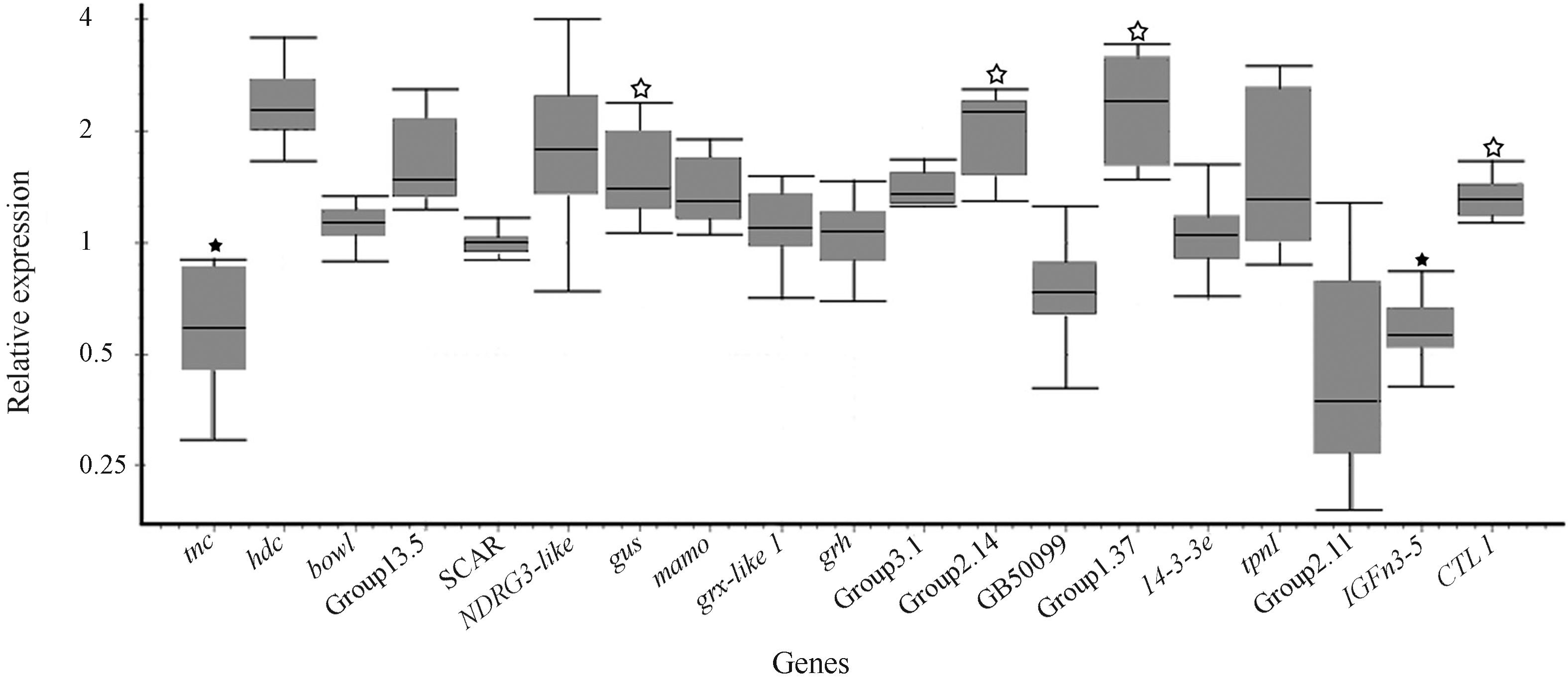| Group1.3 |
GB50376 |
CG33197 |
|
metal ion bindingIEA
|
apoptotic process, embryo development, muscle organ development, regulation of gene expression, compound eye photoreceptor cell differentiation |
| Group1.40 |
GB49260 |
CG43164 |
|
unknown |
unknown |
| Group3.4 |
GB49076 |
CG8671 |
|
unknown |
dsRNA transport |
| Group3.8 |
GB55797 |
CG2944 gustavus
|
|
protein bindingIPI
|
dorsal appendage formation, germ cell development, oocyte anterior/posterior axis specification |
| Group3.9 |
GB53632 |
CG13648 tenectin
|
|
integrin bindingIDA
|
embryonic hindgut morphogenesis, imaginal disc-derived wing morphogenesis, epithelial tube morphogenesis |
| Group3.15 |
GB47014 |
CG4636 SCAR
|
|
protein bindingIPI, actin bindingIEA
|
actin cytoskeleton organization, cell adhesion mediated by integrin, compound eye morphogenesis |
| Group4.1 |
GB49650 |
CG30497 |
|
unknown |
unknown |
| Group4.1 |
GB50425 |
CG45477 maternal gene required for meiosis
|
|
chromatin bindingIDA, sequence-specific DNA bindingIDA, metal ion bindingIEA
|
female meiotic division, regulation of chromatin organization, regulation of transcription from RNA polymerase II promoter |
| Group5.15 |
GB47845 |
CG2302 Nicotinic Acetylcholine Receptor alpha 7E |
|
acetylcholine receptor activityIDA
|
cation transport |
| Group6.10 |
GB54474 |
CG15669 Misexpression suppressor of KsR2
|
|
unknown |
unknown |
| Group6.14 |
GB52211 |
CG5215 Zinc-finger protein at 72D |
|
mRNA bindingISS, zinc ion bindingIEA
|
phagocytosis, mRNA splicing, via spliceosome |
| Group7.9 |
GB42560 |
CG31196 14-3-3ε |
|
protein binding IPI, protein heterodimerization activityIPI
|
determination of adult lifespan, DNA damage checkpoint, germarium-derived oocyte fate determination, regulation of mitosis; wing disc dorsal/ventral pattern formation |
| Group10.23 |
GB48399 |
CG6890 Tollo
|
|
transmembrane receptor activityISS
|
innate immune response in mucosa, peripheral nervous system neuron development, regulation of protein glycosylation |
| Group10.25 |
GB52624 |
CG17077 pointed
|
|
protein bindingIPI, repressing transcription factor bindingIPI
|
anatomical structure development; localization; post-embryonic organ morphogenesis; anterior/posterior axis specification |
| Group11.16 |
GB47245 |
CG33141 sticks and stones
|
|
protein bindingIPI
|
actin cytoskeleton organization, compound eye morphogenesis, myoblast fusion, nephrocyte filtration, spermatid development |
| Group11.18 |
GB44976 |
CG14029 vrille
|
|
RNA polymerase II core promoter proximal region sequence-specific DNA binding transcription factor activity involved in negative regulation of transcriptionIDA
|
circadian rhythm; bristle morphogenesis; imaginal disc-derived wing hair organization |
| Group11.18 |
GB44972 |
CG17484 Adherens junction protein p120
|
|
cadherin bindingIEA
|
adherens junction maintenance; cell adhesion; compound eye morphogenesis |
| Group13.12 |
GB49901 |
CG10021 brother of odd with entrails limited
|
|
metal ion binding IEA; nucleic acid binding IEA, sequence-specific DNA binding RNA polymerase II transcription factor activityISS
|
imaginal disc-derived leg morphogenesis, lateral inhibition, embryonic foregut morphogenesis, embryonic hindgut morphogenesis |
| Group13.12 |
GB49872 |
CG6831 rhea
|
|
integrin bindingIPI, protein bindingIPI
|
apposition of dorsal and ventral imaginal disc-derived wing surfaces, border follicle cell migration, cell adhesion, muscle attachment, regulation of cell shape |
| Group14.14 |
GB52743 |
CG10847 encore
|
|
nucleic acid binding IEA
|
germarium-derived oocyte fate determination; cystoblast division; oogenesis; germarium-derived egg chamber formation |
| Group14.15 |
GB41625 |
CG13676 |
|
chitin bindingIEA
|
chitin metabolic process |
| Group15.19 |
GB50099 |
CG33521 |
|
zinc ion bindingIEA
|
unknown |
| Group15.19 |
GB50117 |
CG15532 headcase
|
|
unknown |
RNA interference; axon extension involved in development; neurogenesis |
| Group16.2 |
GB54355 |
CG5654 ypsilon schachtel
|
|
DNA bindingIEA
|
mRNA splicing, via spliceosome, oogenesis, regulation of transcription, DNA-template |
| Group16.8 |
GB45968 |
CG4145 Collagen type IV
|
|
extracellular matrix structural constituentIEA
|
cardiac muscle cell development, oviduct morphogenesis |
| Group1.20 |
|
|
osa-MIR5149 |
|
|
| Group1.37 |
|
|
sbi-MIR396c |
|
|
| Group3.3 |
|
|
mmu-mir-466f-3 |
|
|
| Group8.21 |
|
|
sbi-MIR396c |
|
|
| Group16.2 |
|
|
smo-MIR1082a |
|
|




